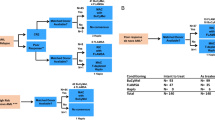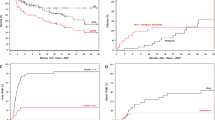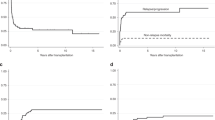Abstract
The purpose of this study was to determine the long-term results of allogeneic bone marrow transplantation for chronic myeloid leukemia. A retrospective analysis was carried out of the outcome of 373 consecutive transplants performed at 38 European institutions between 1980 and 1988 and reported to the registry of the European Group for Blood and Marrow Transplantation. All transplants were carried out for first chronic phase of chronic myelogenous leukemia using unmanipulated marow cells from HLA-identical sibling donors. The probability of survival and leukemia-free survival at 8 years were 54% (95% CI: 49–59) and 47% (95% CI: 41–52) respectively. The probabilities of developing acute GVHD (II–IV) at 100 days and chronic GVHD at 4 years after transplant were 47% (95% CI: 41–53) and 52% (95% CI: 46–58) respectively. The probabilities of transplant-related mortality and leukemic relapse 8 years after BMT were 41% (95% CI: 36–48) and 19% (95% CI: 14–25), respectively. Transplant within 12 months of diagnosis was associated with reduced transplant-related mortality (34 vs 45%, P = 0.013) and resulted in improved leukemia-free survival (52 vs 44%, P = 0.03). The probability of relapse was significantly reduced in patients who developed chronic GVHD (RR = 0.33, P = 0.004). The probability of relapse occurring more than 2 years after transplant was increased more than five-fold in patients transplanted from a male donor (RR = 5.5, P = 0.006). Sixty-seven patients in hematologic remission were studied for residual disease by two-step RT/PCR for BCR-ABL mRNA and 61 (91%) tested negative. We conclude that bone marrow transplantation can induce long-term survival in approximately one-half of CML patients; the majority of survivors have no evidence of residual leukemia cells when studied by molecular techniques. The probability of late relapse is increased with use of a male donor.
This is a preview of subscription content, access via your institution
Access options
Subscribe to this journal
Receive 12 print issues and online access
$259.00 per year
only $21.58 per issue
Buy this article
- Purchase on Springer Link
- Instant access to full article PDF
Prices may be subject to local taxes which are calculated during checkout
Similar content being viewed by others
Rights and permissions
About this article
Cite this article
van Rhee, F., Szydlo, R., Hermans, J. et al. Long-term results after allogeneic bone marrow transplantation for chronic myelogenous leukemia in chronic phase: a report from the Chronic Leukemia Working Party of the European Group for Blood and Marrow Transplantation. Bone Marrow Transplant 20, 553–560 (1997). https://doi.org/10.1038/sj.bmt.1700933
Received:
Accepted:
Issue Date:
DOI: https://doi.org/10.1038/sj.bmt.1700933
Keywords
This article is cited by
-
Risk factors for outcome after allogeneic stem cell transplantation in patients with advanced phase CML
Bone Marrow Transplantation (2021)
-
Efficiency of allogeneic hematopoietic SCT from HLA fully-matched non-sibling relatives: A new prospect of exploiting extended family search
Bone Marrow Transplantation (2015)
-
Curing Chronic Myeloid Leukemia
Current Hematologic Malignancy Reports (2012)
-
Long-term follow-up of allogeneic bone marrow transplantation for patients with chronic phase chronic myeloid leukemia prepared with a regimen consisting of cyclophosphamide, cytarabine and single-dose total body irradiation conditioning
Bone Marrow Transplantation (2007)
-
A 10-year median follow-up study after allogeneic stem cell transplantation for chronic myeloid leukemia in chronic phase from HLA-identical sibling donors
Leukemia (2005)



